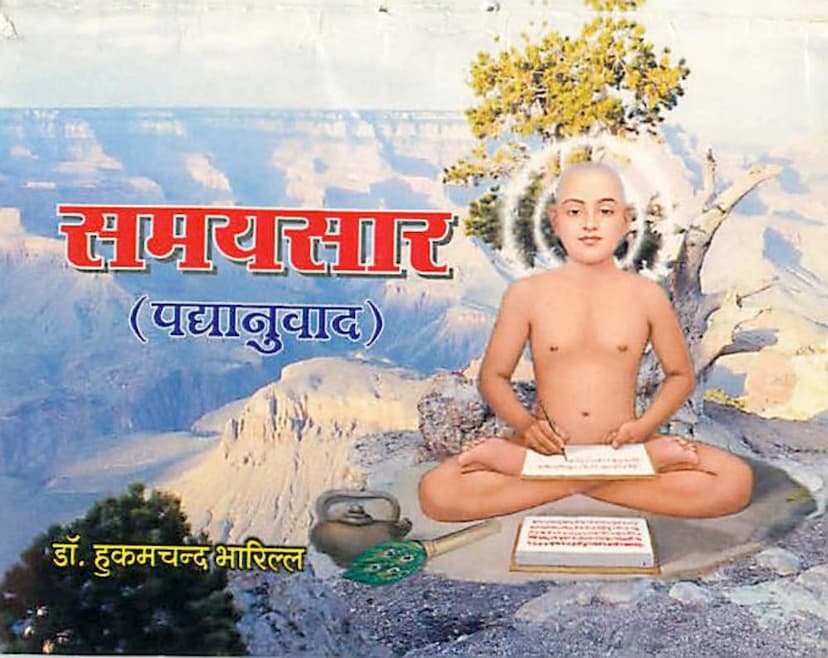Samaysara Padyanuwad
Added to library: September 2, 2025

Summary
Here's a comprehensive summary of the Jain text "Samaysara Padyanuwad" by Dr. Hukamchand Bharilla, based on the provided text:
Book Title: Samaysara Padyanuwad (Poetic Translation of Samaysara) Author: Dr. Hukamchand Bharilla Shastri Publisher: Pandit Todarmal Smarak Trust, Jaipur Catalog Link: https://jainqq.org/explore/009473/1
Overview:
"Samaysara Padyanuwad" is a poetic rendition of the seminal Jain scripture "Samaysara" by Acharya Kundakunda. Dr. Hukamchand Bharilla has undertaken the challenging task of translating the profound philosophical concepts of the original text into a simple, accessible, and melodious poetic form. The book aims to make the essence of Samaysara available to a wider audience, enabling even the simplest seeker of the soul to understand its core teachings.
Key Themes and Content:
The translation follows the structure of Samaysara, elucidating the nature of the soul, karma, the distinction between the soul and non-soul (jiva and ajiva), the principles of causality, and the path to liberation. Here's a breakdown of the major themes covered in the translated verses:
-
The Nature of the Soul (Jiva):
- The soul is presented as pure consciousness, characterized by knowledge (jnana), perception (darshan), and conduct (charitra).
- It is distinct from any physical form, colors, tastes, smells, or touch.
- The soul is not affected by external substances or actions. It is the knower and perceiver, but not the doer of actions related to karma or non-karma.
- The text emphasizes the soul's inherent purity, bliss, and omniscience, which are obscured by karmic coverings.
-
Distinction Between Soul and Non-Soul (Jiva and Ajiva):
- A significant portion of the text is dedicated to clearly differentiating the soul from all non-soul entities, particularly karmic matter (karma and nokarma).
- It refutes the false identification of the soul with the body, senses, emotions (like anger, pride, deceit, greed), thoughts, or any other material manifestation.
- The concept of "Anekantavada" (non-absolutism) is implicitly present, as the text navigates the distinction between what is true in "Nishchaya Naya" (ultimate truth) and "Vyavahara Naya" (conventional truth).
-
Karma and Causality:
- The text elaborates on how karma, which is impure karmic matter, binds the soul.
- It explains that actions, thoughts, and speech are not the direct cause of bondage, but rather the underlying intentions and attachments (adhyavasana) are the true causes.
- The verses clarify that while karma influences the soul's experience, the soul itself is not the doer of karmic actions; rather, karmic matter undergoes transformation due to its own nature and the soul's ignorance.
- The concept of "Nimit" (instrumental cause) and "Upadan" (material cause) is discussed in relation to the soul and karma's interaction.
-
The Paths to Liberation (Moksha):
- The text highlights the importance of "Samyak Darshan" (right faith), "Samyak Jnana" (right knowledge), and "Samyak Charitra" (right conduct) as the means to liberation.
- It emphasizes the cessation of desires, attachments, and the ignorance of one's true nature.
- The verses describe liberation as the state of being free from all karmic bondage and experiencing the soul's inherent pure consciousness.
- The verses touch upon the importance of detachment, renunciation of external possessions and worldly desires.
-
Nays (Perspectives):
- The text navigates the concept of "Naya" (perspective or viewpoint) to explain complex spiritual truths. It distinguishes between "Nishchaya Naya" (ultimate reality) and "Vyavahara Naya" (conventional or worldly reality).
- For instance, while conventionally the soul might be said to perform actions or experience consequences, ultimately, it is only the soul's own pure consciousness that remains unchanged.
-
Practical Implications for the Seeker:
- The verses encourage introspection and self-realization.
- They guide the reader to remain steadfast in their true nature, not to be swayed by external attractions or repulsions.
- The emphasis is on recognizing the soul as the sole refuge and source of liberation.
Praise for the Translation:
The "Prakashkiya" (Foreword for the Fourth Edition) highlights the success of Dr. Bharilla's translation. It notes:
- The original publication was for the Acharya Kundakunda Bicentennial celebration.
- The demand for the book has been immense, with over 20,200 copies sold before the fourth edition.
- The translation is praised for its simplicity, clarity, and ease of understanding, requiring no external commentary.
- It is considered authentic and effective in presenting the original subject matter.
- The translation has been made more accessible through musical cassettes, which have been warmly received by the spiritual community.
Overall Significance:
"Samaysara Padyanuwad" by Dr. Hukamchand Bharilla serves as a bridge between the profound and often intricate philosophy of Acharya Kundakunda and the common seeker. By transforming the original prose into a lyrical and easily digestible form, it makes the path to self-realization and spiritual understanding more accessible, contributing significantly to the dissemination of Jain spiritual wisdom. The publisher's dedication to making this work available at a low cost further underscores its commitment to spreading these valuable teachings.